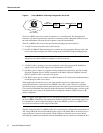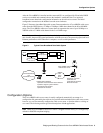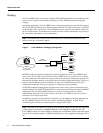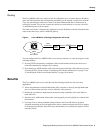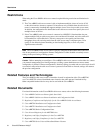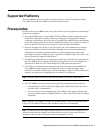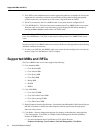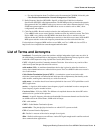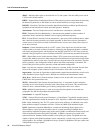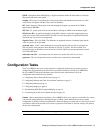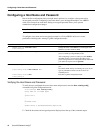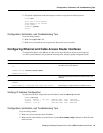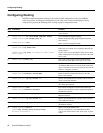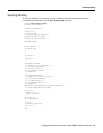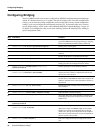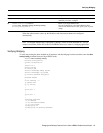
List of Terms and Acronyms
10
Cisco IOS Release 12.0(5)T
dBmV—Decibels with respect to one millivolt in a 75-ohm system. The unit of RF power used in
CATV work in North America.
DHCP—Dynamic Host Configuration Protocol. This protocol provides a mechanism for allocating
IP addresses dynamically so that addresses can be reused when hosts no longer need them.
DOCSIS—Data Over Cable Service Interface Specification. Defines technical specifications for
equipment at both subscriber locations and cable operators’ headends.
downstream—The set of frequencies used to send data from a headend to a subscriber.
FDM—Frequency Division Multiplexing. A data transmission method in which a number of
transmitters share a transmission medium, each occupying a different frequency.
FEC—Forward Error Correction. In data transmission, a process by which additional data is added
that is derived from the payload by an assigned algorithm. It allows the receiver to determine if
certain classes of errors have occurred in transmission and, in some cases, allows other classes of
errors to be corrected.
headend—Central distribution point for a CATV system. Video signals are received here from
satellite (either co-located or remote), frequency converted to the appropriate channels, combined
with locally originated signals, and rebroadcast onto the HFC plant. For a CATV data system, the
headend is the typical place to create a link between the HFC system and any external data networks.
HFC—Hybrid fiber-coaxial (cable network). Older CATV systems were provisioned using only
coaxial cable. Modern systems use fiber transport from the headend to an optical node located in the
neighborhood to reduce system noise. Coaxial cable runs from the node to the subscriber. The fiber
plant is generally a star configuration with all optical node fibers terminating at a headend. The
coaxial cable part of the system is generally a trunk-and-branch configuration.
host—Any end-user computer system that connects to a network. In this document, the term host
refers to the computer system connected to the LAN interface of the cable access router.
ingress noise—Over-the-air signals that are inadvertently coupled into the nominally closed coaxial
cable distribution system. Ingress noise is difficult to track down and intermittent in nature.
MAC layer—Media Access Control sublayer. Controls access by the cable access router to the
CMTS and to the upstream data slots.
MCNS—Multimedia Cable Network System Partners Ltd. A consortium of cable companies
providing service to the majority of homes in the United States and Canada. This consortium has
decided to drive a standard with the goal of having interoperable cable access routers.
MSO—Multiple System Operator. A cable service provider that operates in more than one
geographic area, thus having multiple headend facilities.
narrowband—A single RF frequency.
NTSC—National Television Systems Committee. A United States TV technical standard, named
after the organization that created the standard in 1941. Specifies a 6 MHz-wide modulated signal.
PAL—Phase Alternating Line. The TV system used in most of Europe, in which the color carrier
phase definition changes in alternate scan lines. Utilizes an 8 MHz-wide modulated signal.
QAM—Quadrature Amplitude Modulation. A method of modulating digital signals onto a
radio-frequency carrier signal in which the value of a symbol consisting of multiple bits is
represented by amplitude and phase states of the carrier. QAM is a modulation scheme mostly used
in the downstream direction (64-QAM, 256-QAM). 16-QAM is expected to be usable in the
upstream direction. Numbers indicate number of code points per symbol. The QAM rate or the
number of points in the QAM constellation can be computed by 2 raised to the power of <number
of bits/symbol>. For example, 16-QAM has 4 bits per symbol, 64-QAM has 6 bits per symbol, and
256-QAM has 8 bits per symbol.



